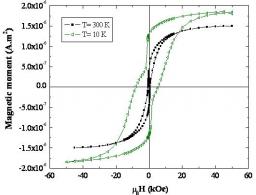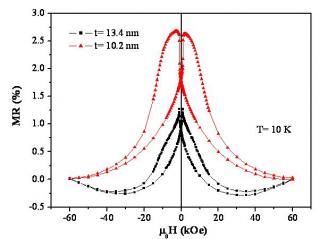Laboratoire Léon Brillouin
UMR12 CEA-CNRS, Bât. 563 CEA Saclay
91191 Gif sur Yvette Cedex, France
+33-169085241 llb-sec@cea.fr
Laboratoire Léon Brillouin
UMR12 CEA-CNRS, Bât. 563 CEA Saclay
91191 Gif sur Yvette Cedex, France
+33-169085241 llb-sec@cea.fr



Figure 1: Magnetic hysteresis loops at 300 K and 10 K obtained at different temperatures on the CoFe2O4(120 nm)/Au(7 nm)/Fe3O4(40 nm) trilayer.
The discovery of the giant magnetoresistance (GMR) effects by Baibich et al. in Fe/Cr ferromagnetic multilayers provoked an important research effort and created the field of spintronics. The total current flow is described as the result of two independent conduction channels with electrons of different spin. Spin-dependent resistance is usually described by two scattering phenomena: one arising from the bulk of the magnetic layers and the other from the diffusion of electrons at the interface between magnetic layers and non-magnetic spacer layers. Two approaches have been used for a theoretical description of the GMR in current in plane (CIP) configuration, the “semiclassical” one deduced from the pioneering work of Fuchs and Sondheimer and the quantum-mechanical Kubo formalism. In the semiclassical approach, spin-dependent bulk resistivities and spin-dependent interfacial resistivities are taken into account. Thus in this model the spin-dependent interfacial resistivity is treated by introducing the proportions of electrons transmitted, specularly reflected, or diffusely scattered from the interfaces. In CIP magnetoresistance experiments, bulk and interface scattering contributions are usually not separable. The work of C. Gatel et al. [1] was to analyze the spin dependence of electron reflection and to experimentally examine the CIP-GMR effect which is only produced by the spin-dependent interfacial reflection. In this framework, the team of the CEMES has grown by sputtering epitaxial trilayers on α-Al2O3(0001) substrates consisting of two ferromagnetic insulating (FI) layers with different coercive fields: CoFe2O4(111) and Fe3O4(111) (which becomes an insulator below the Verwey transition) separated by a non-magnetic metallic (M) Au or Pt layer. The interfacial flatness and the high structural quality of these CoFe2O4/(Au or Pt)/Fe3O4 trilayers have been evidenced by X-ray reflectivity, X-ray diffraction and TEM [1]. One problem that had to be addressed was the 2D epitaxial growth of a thin and continuous metallic layer onto an oxide surface [2]. Figure 1 shows the magnetic hysteresis loops curves obtained in an Au-based system for different temperatures. Magnetic loops exhibit the butterfly-like shape corresponding to the separate switching of the two magnetic layers (first reversal due to Fe3O4).
Figure 2 shows the the magnetoresistance (MR) curves obtained in an Au-based system for different temperatures. The transport measurements have been performed at SPCSI in the CIP configuration on patterned trilayers by using standard optical lithography and Ar plasma etching (coll. SPEC). The resistivity versus temperature curves have shown a genuinely metallic behaviour for the Au and Pt-based systems. The resistivity measurements of the Au-based trilayers at 2 K, around 1.15 10-7 ohm.m , are slightly higher than that of Au pure material but correspond nevertheless to the ones expected for a metallic Au thin film and indicate that the conduction takes place completely within the metallic layer. The MR ratio normalized by the resistance in the nearly parallel state at high field (i.e. 6 T) shows a maximum positive value of 1.8 % at 10 K in this sample with a plateau of about 2000 Oe. The different MR curves present a maximum of the resistance in the range of the magnetic fields where the anti-parallel configuration of the magnetization in the ferromagnetic layers occurs (see hysteresis loops for magnetic comparisons). The GMR decreases with increasing temperature. At 200 K, a GMR of 0.6 % is still measured .

Figure 3: Magnetoresistance (MR) curves obtained at 10 K on the CoFe2O4 (150 nm)/Au(t)/Fe3O4(120 nm) trilayers with t= 10.2 nm and 13.4 nm. The MR varies between 1 % for t= 13.4 nm and 2.5 % for t= 10.2 nm.
The decrease of the GMR with increasing metallic thickness (figure 3) suggests that this GMR effect is clearly an interface phenomenon. The resistivities of CoFe2O4 and Fe3O4 at 10 K are indeed many orders of magnitude higher than that of Au (or Pt); therefore the electrons are perfectly confined in the metallic layer and bulk spin-dependent scattering into the ferrite layers seems unlikely. Thus, we believe that the GMR observed is due to the spin dependence of the electron reflections at the M/FI interfaces [1], [3], [4]. In Fuchs-Sondheimer model, two kinds of spin-dependent electron reflections: diffuse and specular, must be taken into account. Electron reflections strongly depend on the interface quality: a rough interface will favour diffuse reflections while specular reflections will be only produced in the case of a flat interface. In the Au- and Pt-based trilayers presented here, even if the presence of defects at the interface on the atomic scale (not seen in TEM micrographs) responsible for a spin-dependent diffuse scattering can not be completely ruled out, a large part of the measured CIP-GMR effect is due to the spin-dependent specular reflections. The decrease of the GMR with the increase of the Au/FI interfaces roughness (N+ ions implantation) observed by the CEMES group [1], [4] confirms this assumption.
[1] C. Gatel, Ph.D. thesis, University Paul Sabatier (2004).
[2] C. Gatel and E. Snoeck, Surf. Sci. 600, 2650 (2006).
[3] E. Snoeck, Ch. Gatel, R. Serra, J.C. Ousset, J.-B. Moussy, A. Bataille, M. Pannetier and M. Gautier-Soyer, Mat. Sci. and Eng. B 126, 120 (2006).
[4] E. Snoeck, Ch. Gatel, R. Serra, G. BenAssayag, J.-B. Moussy, A. M. Bataille, M. Pannetier, and M. Gautier-Soyer, Phys. Rev. B 73, 104434 (2006).
•  Électronique et optique du futur › Nanomagnétisme et oxydes : spintronique, matériaux multiferroïques et nouveaux capteurs magnétiques
Électronique et optique du futur › Nanomagnétisme et oxydes : spintronique, matériaux multiferroïques et nouveaux capteurs magnétiques
• Service de Physique et Chimie des Surfaces et des Interfaces • Laboratory of Physics and Chemistry of Surfaces and Interfaces
• Laboratoire des Interfaces et Surfaces d'oxydes (LISO) • Laboratory of Oxide Surfaces and Interfaces
